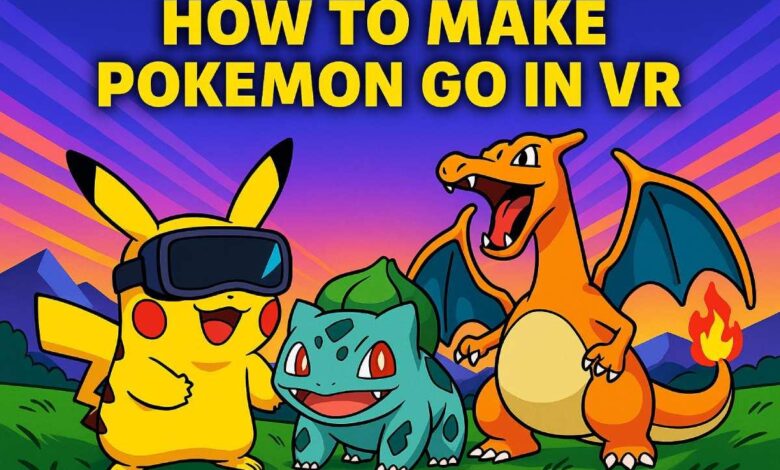Creating Pokémon GO in Virtual Reality: Step-by-Step with VR Experts

Creating a Virtual Reality (VR) version of Pokémon Go is an exciting venture. It combines the elements of augmented reality gaming with immersive VR experiences. As technology advances, players seek more engaging interactions in their favorite games.
In this article, we will explore how to develop a Pokémon Go VR experience effectively. We’ll discuss essential aspects like collaborating with a VR studio and leveraging VR gaming development tools.
The Rise of Augmented Reality in Gaming
Augmented reality gaming, exemplified by Pokémon Go, has transformed how players interact with the digital world by overlaying virtual elements onto the physical environment. This fusion of real and virtual worlds has been a critical step in gaming innovation. AR has allowed players to interact with their surroundings in new and exciting ways, turning everyday locations into part of the gaming landscape. This integration has not only enhanced gameplay but also encouraged physical activity and social interaction among players. As this immersive trend continues, Virtual reality game development is advancing in parallel, pushing the boundaries of player immersion by transporting users into fully interactive virtual environments that complement and expand upon the innovations brought by AR.
The Immersive Experience of Virtual Reality
Virtual reality, on the other hand, immerses players entirely in a digital universe, offering a distinct experience where the virtual environment is the only reality perceived by the player. Unlike AR, VR takes players into a completely constructed world, allowing them to explore and interact within an environment that feels tangible and real. This immersive quality of VR can create a sense of presence that is unparalleled, making players feel as though they are genuinely part of the virtual world. The potential to explore fantasy landscapes or real-world scenarios in VR brings a new dimension to gaming experiences.
The Convergence of AR and VR Technologies
The convergence of AR and VR technologies promises a new era in gaming, where players can engage with games in ways previously deemed impossible. By combining the interactive elements of AR with the immersive environments of VR, developers can create hybrid experiences that offer the best of both worlds. This convergence is not only about technological advancement but also about reimagining how players engage with digital content. The development of a VR version of Pokémon Go would not only require a deep understanding of these technologies but also innovative thinking to maintain the essence of the original game while leveraging the capabilities of VR.
Key Considerations for Pokémon Go VR Development
Understanding the Core Mechanics
A successful VR adaptation of Pokémon Go must maintain the core mechanics that made the original game engaging. This involves creating a seamless experience where players can explore their surroundings and capture Pokémon in a fully immersive environment. Developers must consider how to translate the AR features into VR, ensuring that the mechanics remain intuitive and engaging for players. The challenge lies in preserving the thrill of discovery and the excitement of capturing Pokémon while adapting to a new medium.
Designing an Immersive World
Designing a VR world for Pokémon Go requires careful attention to detail. Developers need to create diverse environments that reflect the real world while offering unique, fantastical elements. The game world must be rich and varied, providing players with numerous locations to explore and interact with. The visual aesthetics, audio elements, and interactive features must work together to create a cohesive and engaging environment. This includes designing ecosystems where Pokémon naturally appear, making the world feel alive and dynamic.
Enhancing the User Experience
The user experience in VR is fundamentally different from AR. It requires careful attention to detail in terms of visual and auditory feedback, user interface design, and interaction mechanics. Developers need to create a VR environment that feels natural and responsive, allowing players to interact with Pokémon and their surroundings in a lifelike manner. This includes designing intuitive controls and providing feedback that enhances the sense of immersion. The experience should be seamless and intuitive, ensuring that players can focus on the game rather than struggling with controls or interfaces.
Technical Challenges and Solutions
Transitioning from AR to VR presents several technical challenges. Developers must consider the hardware limitations of VR devices, such as processing power, battery life, and display quality. Additionally, creating a VR world that accurately represents the real world requires sophisticated mapping and tracking technologies. These challenges necessitate collaboration with experienced VR developers and studios to ensure that the technical aspects of the game meet the required standards. Solutions may involve optimizing game performance, enhancing tracking accuracy, and ensuring compatibility with various VR platforms.
Safety and Comfort in VR Gaming
One of the key considerations in VR gaming is ensuring player safety and comfort. Extended play sessions can lead to discomfort or motion sickness, so developers must design the game with these factors in mind. This involves creating smooth transitions, minimizing rapid movements, and providing options for players to adjust settings according to their comfort levels. Ensuring a safe and enjoyable experience is crucial for the success of any VR game, including Pokémon Go.
Collaborating with a VR Studio
Selecting the Right VR Studio
When choosing a VR studio, it is crucial to consider their experience in VR game development and their understanding of AR technologies. Look for a studio with a proven track record of successful projects, particularly those that have pushed the boundaries of what is possible in VR gaming. A studio with a strong portfolio and positive client feedback can be a reliable partner in realizing the vision for Pokémon Go VR. Consider their expertise in creating immersive environments and their ability to integrate AR elements into VR experiences.
Collaborative Development Process
A collaborative development process involves close communication between the game developers and the VR studio. This partnership should focus on aligning the project goals, sharing knowledge and expertise, and iterating on the design and functionality of the game. By fostering a collaborative environment, both parties can contribute their strengths to create a VR experience that captures the essence of Pokémon Go while leveraging the immersive capabilities of VR. For studios looking to bring such ambitious projects to life, the decision to hire dedicated virtual reality developers with the right technical skills and creative vision becomes essential. Regular meetings, feedback sessions, and collaborative brainstorming are also key to ensuring the project stays on track and achieves its objectives.
Leveraging VR Studio Expertise
VR studios bring a wealth of expertise to the development process. Their knowledge of VR hardware, software, and user experience design can be invaluable in overcoming technical challenges and enhancing the overall quality of the game. By leveraging their expertise, developers can create a more polished and engaging VR experience. The studio’s insights into player behavior and preferences can also inform design decisions, ensuring that the game resonates with its target audience.
Building a Strong Partnership
Building a strong partnership with a VR studio is essential for the success of the project. This involves establishing clear communication channels, setting realistic timelines, and defining roles and responsibilities. A successful partnership is built on trust, mutual respect, and a shared vision for the project. By working closely together, the development team and the VR studio can achieve a level of synergy that enhances the creative process and results in a high-quality product.
Pokémon Go Updates and Future Prospects
As the gaming landscape continues to evolve, Pokémon Go itself is not static. Regular updates and new features keep the player base engaged and excited about the game. Integrating VR into Pokémon Go could be a natural progression, offering players a new way to experience the beloved game.
Potential Features and Enhancements
A VR version of Pokémon Go could introduce a range of new features and enhancements. Imagine exploring the Pokémon world in first-person, interacting with Pokémon in a more tangible way, and experiencing battles with heightened realism. The possibilities are vast and limited only by the creativity and technical expertise of the development team. New mechanics could involve advanced battle systems, team-based challenges, and real-world events that integrate with the virtual world, providing players with a richer and more interactive experience.
The Impact on the Gaming Community
The introduction of VR to Pokémon Go could spark new debates and discussions within the gaming community. How will players respond to the increased immersion? What challenges and opportunities will arise from integrating VR into a game originally designed for AR? Engaging with the gaming community and soliciting feedback can provide valuable insights into how the game is received and where further improvements can be made. The community’s response can guide future updates and expansions, ensuring that the game continues to evolve in ways that resonate with its audience.
Exploring New Business Models
The integration of VR into Pokémon Go could also lead to new business models and revenue streams. In-game purchases, subscription models, and partnerships with other brands could be explored to monetize the VR experience. Additionally, location-based advertising and sponsorships could enhance the game’s profitability while providing value to players. By exploring these opportunities, developers can ensure that the VR adaptation of Pokémon Go is both a commercial and creative success.
Long-Term Vision and Goals
As developers consider the future of Pokémon Go, a long-term vision and set of goals are essential. This includes planning for future expansions, updates, and technological advancements that could further enhance the VR experience. By setting clear objectives and anticipating industry trends, developers can position Pokémon Go as a leader in the evolving landscape of AR and VR gaming. The aim should be to create a sustainable and innovative product that continues to captivate and engage players for years to come.
Conclusion
Developing a VR version of Pokémon Go presents an exciting opportunity to push the boundaries of gaming technology and provide players with a new way to experience a beloved game. By understanding the core mechanics, enhancing the user experience, and collaborating with a VR studio, developers can overcome the challenges associated with this ambitious project. As the gaming industry continues to evolve, the integration of AR and VR technologies promises to reshape how players engage with digital worlds. With careful planning and execution, Pokémon Go VR could become a landmark achievement in the evolution of gaming, setting a new standard for immersive and interactive experiences.



